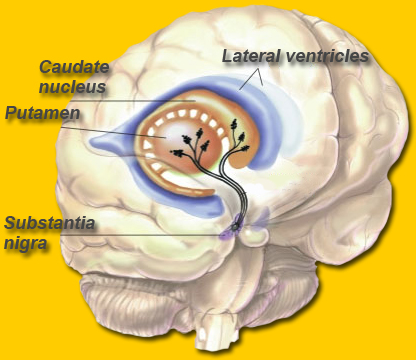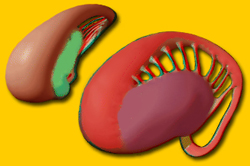Basal ganglia: Caudate nucleus, Putamen, Substantia nigra and Lateral ventricles

Source: stemcells.nih.gov |
 Location of the basal ganglia. Source: hopes.stanford.edu (edited) Disorders: Cerebral palsy, Dystonia; Parkinson's Disease, Huntington's Disease S; Lesch-Nyhan syndrome, Obsessive-Compulsive Disorder S; ADHD S, S, Tourette Syndrome S, Stuttering, Wilson's disease; Schizophrenia S; Depression S; Sexual disorders S, Neurodegeneration associated with brain iron accumulation S |
|
Functions: Motor skills; motion selection, initiation and control:
information transfer from the (P)FC and the
parietal cortex via the
basal ganglia and the thalamus up to the
SMA (part of the motor cortex);
above all inhibition of unwanted/ inappropriate movements but also
coordination of volitional movements, postures
S
Procedural memory Attention (dopamine) S; processing of different emotional and cognitive stimuli (reward system, reinforcement, Addiction, habits) S (see below) Modulation of pain perception S Quod vide: Claustrum, Striatum, Nucleus caudatus, Globus pallidus, Nucleus accumbens und Putamen |
 Putamen. Source
Putamen. Source
|
ClaustrumFunctions: Consciousness; joining of different attributes into one object (sensory synchronization); synchronization of different perceptual, cognitive and motor modalities S; claustrocortical network for sensory integration SProcessing of visual sexual stimuli Caudate nucleusFunctions: Movement control S, Motor memory (Dopamine) SLanguage control (left: changes in the language or the meaning of words) S; Speech processing (e.g. ambivalence) S Perceptual skill learning S; Reaction to positive and negative feedback during learning S, left hemisphere: detection of a change in the 'context' and the subsequent formulation of a new 'rule' S; the linking of action to outcome S Obsessions, compulsions S Memory S, working memory S; Visualization of emotional events in the near future; concrete simulations of action plans to achieve rewarding situations in the near future S Love S, motherly love S Pain S Disorders: Obsessive-Compulsive Disorder S, S; Major Depression (left hemisphere) S, Parkinson's Disease (Serotonin) S, Huntington's Disease S, S; Schizophrenia S; Autism S; Addiction (Cocaine) S Globus pallidusFunctions: Motion facilitation (lateral segment) and motion inhibition (medial segment); acts as an "antagonist" of the Striatum; sends inhibiting impulses to the Thalamus and the Nucleus subthalamicusImportant part of the reward system S Sexual arousal and behavior S Tourette Syndrome (GABA) S, Parkinson's Disease (GPI) S, Huntington's Disease S, Anhedonia/ Depression S; Dyskinesia S, Dystonia S, Tremor, Acampsia, Bradykinesia; Addiction (Cocaine; ventral) S, loss of craving S; Pedophilia S, Progressive supranuclear palsy S |
StriatumFunctions: 'Entrance' to the basal ganglia; strong interconnections to the neocortex; attention -> many dopamine receptors SWorking memory S; skill acquisition (cognitive, perceptive, motor) S Executive: Interplay of motivation, emotion, cognition and motion on a neuronal level Activation by rewards S (dopamine, ventral) S and by aversive, novel, unexpected or very intense stimuli Sexual arousal and behavior S * Ventral: Preparation, initiation and execution of reward-related behavior as a result of successful integration of (relevant) emotional and cognitive information (strong connections to the OFC and the ACC) S even when rewards were cued but omitted S * Dorsal: Reward system, adjustments after delivered rewards S, categorization S Disorders: Striatofrontal dysfunction: Depression S, S, Chronic Schizophrenia S, Obsessive-Compulsive Disorder S (serotonergic hypofunction), Borderline PD S, Pedophilia S, ADHD S, Tremor S, Parkinson's Disease (Dopamine), Huntington's Disease (GABA) S, S; Athetosis, Dyskinesia; Addiction (Dopamine) S, S; Anorexia Nervosa S Nucleus accumbensFunctions: Important part of the reward system, emotional learning, operant conditioning, motivation S, selbst-reference S; sympathy/ preference (unknown faces) S; empathy/ friendship S; craving SDisorders: Addiction S, Depression S, S; Bipolar Disorder S PutamenFunctions: Reinforcement learning; efficiency SMotor memory (Dopamine) S Speech processing (e.g. ambivalence) S Disorders: Huntington's Disease S, Parkinson's Disease (Serotonin) S, Obsessive-Compulsive Disorder S; Addiction (Cocaine) S |
External Link Disclaimer: We as the creators of Brain-Maps.com are not responsible for the contents or reliability of any linked websites and do not necessarily endorse the views expressed within them. The listing of a link shall not be taken as endorsement of any kind. We cannot guarantee that these links will work all of the time and we have no control over the availability of linked pages.
Please note: While we as the creators of Brain-Maps.com make every effort to post the most accurate and reliable information, we do not guarantee or warrant that the information on this web site is complete, accurate or up-to-date. We assume no responsibility for the use or application of any posted material. This web site is intended solely for the purpose of electronically providing both the public and scientists with brain-related information and convenient access to the data resources. We assume no responsibility for any error, omissions or other discrepancies between the electronic and printed versions of documents.
We do not provide individual advice or counseling, whether medical, legal, or otherwise. If you are seeking specific advice or counseling, you should contact a licensed medical practitioner or professional. For comments, corrections or suggestions please send us an e-mail »